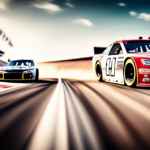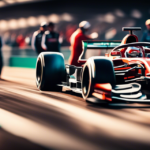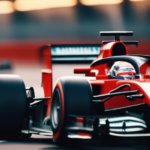How to Pick the Winner in Formula 1 Racing
I’ve spent years immersed in the world of Formula 1 racing, studying every detail from drivers’ performances to track characteristics, even down to the nuances of their shiny, rubber-clad tires. And let me tell you, there is an art to predicting the winner in this high-octane sport. But fear not, as I’ve got a few secrets to share that will undoubtedly boost your chances of making accurate predictions and adding some extra excitement to your race day experience.
Formula 1 racing is an unpredictable sport, and upsets do happen. However, by combining your instinct with critical thinking and employing a well-rounded approach to analyzing the race, you increase your chances of making informed and successful betting decisions.
Understanding Formula 1 Racing
Before we start talking about strategies for picking winners, it’s crucial to have a solid understanding of how this high-octane sport operates.
1. The Basics:
In Formula 1, it’s all about speed, precision, and strategy. Picture this: lightning-fast cars, roaring engines, and drivers pushing the limits of human capability. Each season, a series of races is held on various race tracks around the globe, with the ultimate aim of crowning the World Champion.
2. Cars and Teams:
Formula 1 cars are marvels of engineering, crafted with utmost precision and cutting-edge technology. These machines are capable of reaching mind-boggling speeds of over 220 mph (354 km/h). But it’s not just about the car – teams play an equally important role. From the mechanics tinkering under the hood to the strategists fine-tuning race tactics, every element must work in sync for success.
3. The Race Weekend:
A typical Formula 1 race weekend consists of three main events: Practice sessions, Qualifying, and the Race itself. During practice sessions, drivers familiarize themselves with the track, fine-tune their cars, and gather vital data. Qualifying determines the starting grid positions for the race, with the fastest driver securing pole position. And finally, the Race is where the high-stakes action unfolds, as drivers battle it out for victory, overtaking, and avoiding pitfalls.
4. Tire Strategy:
Tires hold the key to achieving optimal performance on the track. Compounds and tire degradation become critical factors during races. Teams must choose the right time to pit and change tires, balancing grip and speed to maintain an advantage. The right tire strategy can make or break a race, adding an extra layer of excitement and unpredictability.
5. Driver Skill and Style:
Now, let’s not forget the real stars of Formula 1 – the drivers themselves. These daredevils possess unparalleled skill, nerves of steel, and lightning-quick reflexes. Each driver has their unique style and approach to racing, which can greatly impact their success on the track. Some thrive in wet weather conditions, while others excel at overtaking or managing tire wear.
Phew! We’ve covered the essentials of Formula 1 Racing. Take a moment to let that adrenaline pump through your veins because in the next section, we’ll be exploring some kickass strategies to help you become a winner picker in this mesmerizing sport.
So, grab a cold one, my fellow racing enthusiasts, and get ready to unleash your inner racing guru. The thrill of Formula 1 is waiting for us, just around the corner.
Researching the Drivers
Alright, ladies and gentlemen, welcome to the exciting world of Formula 1 racing! In order to successfully pick the winner, we need to look beyond the roaring engines and flashy cars. We need to delve into the details and understand the drivers themselves. So, let’s grab our virtual helmets and jump right into it!
1. Driver Performance:
The first and most crucial factor to consider is the performance of the drivers. Take a look at their track records, including their previous races, podium finishes, and overall standing in the championship. Pay attention to their consistency, ability to handle pressure, and track-specific performances. Remember, not all drivers are created equal on every circuit!
2. Team Dynamics:
Formula 1 racing is not just about the driver; it’s a team effort. Consider the relationship between the driver and their team. A harmonious and efficient team can provide the necessary support and resources for a driver to excel. Look into a team’s historical success, their technical capabilities, and any recent changes in personnel or partnerships. Keep in mind that a well-coordinated team leads to a better driver performance.
3. Car Performance:
When it comes to Formula 1, the car is undeniably a critical component. Analyze the car’s aerodynamics, engine power, and overall reliability. Keep yourself up to date with any technical upgrades or developments introduced by the team. A fast and technologically advanced car can give a driver a significant advantage on the track.
4. Track Suitability:
Different tracks have unique characteristics, and some drivers may perform exceptionally well on specific circuits. Consider the track layout, its length, number of corners, straights, and even the weather conditions. Certain drivers may have a knack for high-speed tracks, while others excel in tight and twisty layouts. Understanding how a driver’s style aligns with a particular track can make all the difference in your predictions.
5. Current Form and Momentum:
Lastly, assess a driver’s current form and momentum. Look at their recent performances and see if they have been consistently competitive. Take into account any recent successes or setbacks that may influence their performance. Momentum can play a vital role in a driver’s confidence and overall results.
Remember, my fellow Formula 1 enthusiasts, researching drivers is like diving into their inner workings. It’s about understanding their performances, relationships, team dynamics, car capabilities, track suitability, and current form. By gathering all this knowledge, we can start identifying potential winners in the exhilarating world of Formula 1 racing!
Assessing Team Performance
When it comes to picking a winner in Formula 1 racing, understanding the dynamics of the teams is just as crucial as knowing the drivers themselves. So, let’s rev our engines and get started!
1. Team Funding and Resources:
One of the key factors that influence a team’s performance is their financial stability and resources. Formula 1 is an expensive sport, and teams with larger budgets often have an advantage. They can invest in cutting-edge technology, research and development, and attract top talent. Keep an eye on teams with strong financial backing and substantial resources.
2. Team Dynamics and Culture:
Just like any high-performing sports team, the environment within a Formula 1 team plays a significant role in their success. Look for teams with strong leadership, effective communication, and positive team dynamics. A unified team working towards a common goal tends to perform better on the race track.
3. Technical Capabilities:
Formula 1 racing is all about pushing the boundaries of technology. Teams that have a track record of innovation and technical excellence tend to excel in the sport. Consider factors such as their engineering prowess, aerodynamic expertise, and ability to adapt to evolving regulations. A team with a strong technical foundation is more likely to produce a winning car.
4. Past Performance and Track Record:
Don’t forget to look at the team’s history and track record over recent seasons. Review their results, podium finishes, and the consistency of their performance. Form is essential in Formula 1, and teams that have consistently performed well in the past are more likely to continue their success in the future.
5. Partnerships and Collaborations:
Teams in Formula 1 often form partnerships with various sponsors, suppliers, and technical partners. These collaborations can have a significant impact on a team’s performance. Look for teams that have strong partnerships, as they can provide additional resources, expertise, and support to enhance their on-track performance.
6. Pit Crew and Technical Staff:
While we often focus on the drivers, let’s not forget the unsung heroes behind the scenes—the pit crew and technical staff. Teams with highly skilled and experienced pit crews can gain an advantage during critical pit stops, potentially gaining positions on the track. Pay attention to the expertise and efficiency of the technical staff, as their ability to fine-tune the car’s setup can make a considerable difference on race day.
By taking these factors into account and conducting thorough research on a team’s performance and dynamics, you can gain a deeper understanding of their potential for success in Formula 1 racing. Remember, it’s not just about the drivers; it’s a team effort!
Analyzing Track Characteristics and Weather
When it comes to betting on Formula 1, it’s crucial to consider the track characteristics and weather conditions. These factors can have a significant impact on the outcome of a race and can help you make more informed betting decisions. Let’s dive into how track characteristics and weather can influence the race results.
1. Track Characteristics:
Formula 1 circuits come in various shapes and sizes, each with its unique characteristics. Some tracks feature long straights, while others have tight corners or challenging hairpin bends. Understanding these track features and their impact on different teams and drivers is key to successful betting.
Straight Tracks:
On tracks with long straights, teams with powerful engines and excellent straight-line speed tend to have an advantage. Look for drivers and teams known for their top speed and overtaking abilities.
Twisty Tracks:
Courses with numerous corners and tight turns require exceptional handling and agility. Drivers with strong technical skills and teams that excel in aerodynamics and grip will likely perform well.
Street Circuits:
Street circuits are temporary tracks that are set up on city streets. These tracks can be challenging due to their tight nature and limited overtaking opportunities. Consider drivers who have a history of performing well in tight and demanding street circuits.
2. Weather Conditions:
Weather conditions can be highly unpredictable, and they can significantly affect race outcomes. Keep an eye on the weather forecast leading up to the race and consider the following factors:
Rain: Wet conditions can level the playing field and create opportunities for underdog drivers and teams to excel. Some drivers are renowned for their wet weather skills, so research their past performances in rainy conditions.
Heat: Extreme heat can impact tire wear and engine performance. Understand which teams and drivers thrive in hot temperatures and those who may struggle.
Wind: Strong gusts can impact aerodynamics, car stability, and driver control. Take note of drivers who have experience in windy conditions and teams that can adapt quickly to changing wind patterns.
By analyzing and understanding track characteristics and evaluating weather conditions, you can gain valuable insights into how different teams and drivers may perform. This information can prove vital in making informed betting choices.
Pit Strategies and Tire Management
Ah, the pit stop is a crucial aspect of Formula 1 racing. It’s not just about changing tires and refueling; it’s a strategic move that can make or break a race. As a savvy Formula 1 bettor, understanding pit strategies and tire management can give you a significant edge in predicting winners.
1. Pit Strategies:
Pit strategies involve the timing and frequency of pit stops, and they can vary depending on the race and the conditions. Here are a few common pit strategies to consider:
a. One-stop strategy: This strategy involves making a single pit stop during the race. Teams aim to maximize the lifespan of their tires to reduce time spent in the pits. Factors like track conditions, tire wear, and fuel consumption play a role in determining the optimal time for a pit stop.
b. Two-stop strategy: With this strategy, teams make two pit stops during the race. The goal is to use fresh tires to gain a performance advantage over rivals. Factors such as tire degradation and expected changes in weather conditions help teams decide when to perform the additional pit stops.
c. Safety car strategy: During a race, if a safety car is deployed due to an accident or unfavorable weather conditions, it can create a strategic opportunity. Teams might take advantage of the safety car period to make a pit stop and gain positions on the track.
2. Tire Management:
Tires are an essential element in Formula 1 racing, and understanding how teams manage their tire usage can give you valuable insights. Consider the following aspects of tire management:
a. Tire compounds: Formula 1 teams have a choice of different tire compounds provided by the manufacturer. These compounds have various levels of grip and durability. Understanding which compound is suitable for the track conditions and how teams adapt to the use of specific compounds can help you anticipate performance differences between drivers.
b. Tire wear and degradation: Tire wear plays a crucial role in race strategy. As tires degrade over time, drivers experience reduced grip and slower lap times. Monitoring tire wear during practice and qualifying sessions can provide clues about each team’s tire management approach. Additionally, keep an eye on how teams adjust their tire pressures to tailor the handling of the car.
c. Optimal tire temperature: Tire performance is heavily influenced by temperature. Drivers must carefully manage tire temperature to ensure optimal grip. Factors such as track temperature, weather conditions, and driving style can affect tire temperature. Observing how drivers handle tire temperature and adjust their driving style accordingly can help you evaluate their overall performance.
By delving into pit strategies and tire management, you gain a deeper understanding of the intricacies of Formula 1 racing. These factors, coupled with your knowledge of drivers, team performance, track characteristics, and weather conditions, will allow you to make informed predictions when placing your bets.
Incorporating Qualifying Performance
Qualifying sessions, the intense battles where drivers unleash everything they’ve got to secure their positions on the starting grid. Qualifying performance can provide valuable insights into a driver’s skill, car setup, and overall competitiveness for the upcoming race.
1. Understanding Qualifying Formats:
Formula 1 has evolved its qualifying format over the years, so it’s essential to grasp the current system. Currently, the knockout-style qualifying consists of three sessions: Q1, Q2, and Q3.
2. Evaluate Lap Times:
Pay close attention to qualifying lap times. Compare a driver’s performance to their teammates as this can provide a good indication of their relative speed and confidence in the car.
3. Analyze Sector Times:
Breaking down the sector times within the lap can reveal a driver’s strengths and weaknesses on different track sections. Look for consistency, especially in sectors that align with critical overtaking opportunities.
4. Consider Grid Penalties:
Keep an eye out for drivers receiving grid penalties. Penalties for things like engine changes or infringements during previous races can significantly affect a driver’s starting position.
5. Assess Qualifying History:
Look back at previous race weekends to gauge the driver’s qualifying prowess. Consider their average starting position, notable improvements or declines in performance, and any recurring issues.
Remember, qualifying is just one component to consider when predicting race outcomes. It provides valuable information, but it’s crucial to incorporate it alongside other factors like race strategy, reliability, and driver skills during the actual race.
Employing Gut Instinct and Critical Thinking
As much as we rely on data and analysis in Formula 1 racing, there’s also room for that intangible factor called gut instinct. Sometimes, all the stats and numbers won’t tell the whole story, and that’s where critical thinking comes into play.
1. Trust your instincts:
Your gut feeling can often guide you towards making the right decision. After conducting thorough research and considering all the factors, let your intuition guide your final decision. It’s that instinctive sense, that feeling in your bones, that can lead you to the winning choice.
2. Consider external factors:
Formula 1 racing is not just about the cars and drivers, but also about the external circumstances that can influence the outcome. Stay updated on the latest news and developments that could affect a driver’s performance or a team’s strategy. Keep an eye on any conflicts, changes in team personnel, or sponsorship issues, as these can have a significant impact on race results.
3. Factor in driver motivation:
Formula 1 drivers are highly competitive individuals who thrive on the pursuit of victory. Consider the drivers’ motivations, such as their hunger for a championship, their desire to prove themselves, or their record on specific tracks. Drivers with a personal stake in a certain race might push even harder to secure a win.
4. Analyze critical moments:
In any race, there are specific moments that can turn the tide. Look for potential game-changing situations, like a safety car deployment, a pit stop under caution, or adverse weather conditions. These pivotal moments can create opportunities for drivers to gain an advantage or make a strategic move that sets them apart from the pack.
Remember, no approach is foolproof, and even the best-laid plans can go awry. Formula 1 racing is an unpredictable sport, and upsets do happen. However, by combining your instinct with critical thinking and employing a well-rounded approach to analyzing the race, you increase your chances of making informed and successful betting decisions.
Managing Risk and Setting Realistic Expectations
Alright, folks, we’ve covered a lot of ground in our quest to pick the winner in Formula 1 racing. But before we conclude, there are some important aspects we need to discuss – managing risk and setting realistic expectations.
1. Understand that Sports Betting is Never a Guarantee:
First and foremost, it’s crucial to remember that sports betting, including Formula 1 racing, is never a surefire guarantee. Even with our comprehensive analysis and strategies, upsets can happen, and the unpredictability of racing adds to the thrill. So always approach betting with a sense of excitement and a preparedness for any outcome.
2. Establish a Bankroll and Stick to It:
Managing your bankroll is essential to ensure you don’t find yourself in financial turmoil. Before placing any bets, determine the amount you’re comfortable risking and stay disciplined. Don’t be tempted to chase losses by increasing your wager size beyond your means. Consistency is key, so always bet within your predetermined bankroll limits.
3. Embrace Proper Money Management:
To further mitigate risks, it’s crucial to allocate your funds wisely. This means diversifying your bets across different races, drivers, and bet types. By spreading your wagers, you’ll reduce the impact of potential losses on a single race and give yourself more opportunities to come out on top.
4. Set Realistic Expectations:
While it’s exhilarating to dream of enormous winnings, setting realistic expectations is vital. It’s unrealistic to expect to win every bet, and even the most seasoned bettors have their fair share of losses. Instead, focus on long-term profitability and aim for consistent, sustainable success.
5. Practice Self-Discipline:
Becoming a master at picking the winner in Formula 1 racing requires a combination of knowledge, research, intuition, and a touch of bravado. It’s not an easy feat, but with dedication, perseverance, and a good sense of humor, you can undoubtedly improve your success rate.
As we wrap up this guide, I want to leave you with one final thought: Formula 1 racing and sports betting, like any great adventure, are meant to be savored. So, gather your friends, grab some snacks, and let’s dive into the world of high-speed thrills together. May your bets be successful, your excitement sky-high, and your love for racing never waver.
- Grant
Additional Studies:
- Learn Advanced Bankroll Management
 Sports betting can be unpredictable, just like life. You never know when a favorite horse might pull up lame or when the underdog team might pull off a stunning upset.
Sports betting can be unpredictable, just like life. You never know when a favorite horse might pull up lame or when the underdog team might pull off a stunning upset. - NASCAR: Tracks and Features
 You may think that NASCAR is simply about cars zooming around ovals, but it’s so much more than that. Each track has its own unique characteristics and features that pose different challenges to drivers, making every race a thrilling, edge-of-your-seat experience.
You may think that NASCAR is simply about cars zooming around ovals, but it’s so much more than that. Each track has its own unique characteristics and features that pose different challenges to drivers, making every race a thrilling, edge-of-your-seat experience. - Formula 1: The Tracks and Features
 Prepare to dive headfirst into the exhilarating world of Formula 1 racing, where speed, precision, and sheer adrenaline take center stage.
Prepare to dive headfirst into the exhilarating world of Formula 1 racing, where speed, precision, and sheer adrenaline take center stage. - Betting on Formula One Racing: A Beginners Guide
 We’re about to embark on a Formula One journey that will leave you ready to outsmart the odds, make informed decisions, and hopefully, cash in some sweet victories.
We’re about to embark on a Formula One journey that will leave you ready to outsmart the odds, make informed decisions, and hopefully, cash in some sweet victories. - How to Pick the Winner in Formula 1 Racing
 Get ready to uncover the hidden tricks and tips that could turn you into a master of picking the winning drivers. In Formula 1, it’s all about speed, precision, and strategy.
Get ready to uncover the hidden tricks and tips that could turn you into a master of picking the winning drivers. In Formula 1, it’s all about speed, precision, and strategy.
